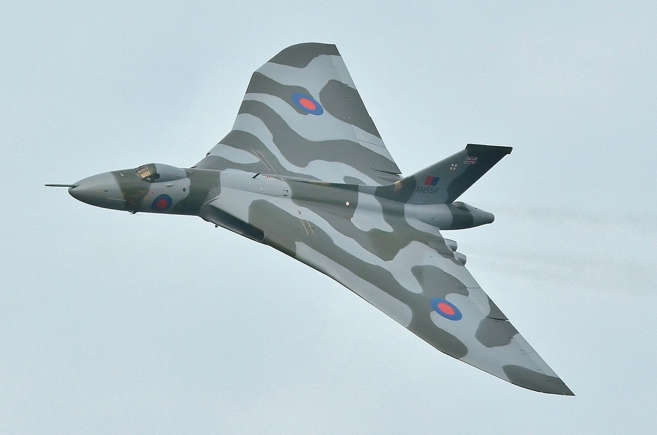
1. Distinctive Delta Wing Design
One of the most striking features of the Vulcan is its large delta‑wing layout, a tailless triangular wing that gave the aircraft both volume and performance advantages.
-
The wing area for early models was about 330.2 m².
-
This configuration allowed a high internal fuel capacity, structural simplicity (no separate horizontal tailplane), and good high‑altitude stability.
-
According to one commentary: “The delta wing is a highly unusual feature for an aircraft that travels slower than the speed of sound, like the Vulcan.
The delta wing remains one of the Vulcan’s most iconic engineering signatures.
2. High‑Altitude Performance & Strategic Reach
The Vulcan was designed for high‑altitude strategic penetration:
-
Service ceiling up to ~55,000 ft (16,800 m) for the B.2 version.
-
Maximum speed around Mach 0.96 (~1,038 km/h) at altitude.
-
Ferry or combat ranges comparable to several thousand kilometres: for example, a ferry range of ~7,400 km for some variants.
These attributes allowed the Vulcan to reach deep into potential adversary territory – part of its role in the UK’s “V‑Bomber” deterrent force.
3. Four Powerful Bristol Siddeley/Olympus Turbojet Engines
The Vulcan was powered by four Bristol Siddeley (later Rolls‑Royce) Olympus turbojets:
-
For example, the B.2 variant had Olympus 301 engines rated around 20,000 lbf thrust each.
-
The configuration provided the required thrust to support high‑altitude, high‑speed flight in a large airframe.
-
Its distinctive “howl” became known among aviation enthusiasts: “The Vulcan engine is loud because it is small… the exhaust velocity needs to be large for a given thrust, and noise increases very rapidly…”
This engine‑outfit gave the Vulcan both power and an unmistakable presence.
4. Large Internal Bomb Bay & Payload Capacity
As a strategic bomber, the Vulcan could carry a substantial internal payload:
-
Maximum bomb‑load around 21,000 lb (~9,500 kg) of conventional bombs.It was also designed to carry British nuclear weapons or the stand‑off missile system “Blue Steel”.
-
For example: “Maximum bomb‑load 21,000 lb … nuclear payloads included Blue Steel missile or free‑fall bombs.
The large internal bay and capability made it a versatile and formidable platform.
5. Sophisticated Avionics & Electronic Countermeasures (ECM)
The Vulcan evolved with advanced avionics for its time, enabling all‑weather and strategic operations:
-
It carried H2S ground‑mapping radar, tail warning systems, and electronic counter‑measure suites.
-
As the missile/air‑defence threat evolved, the Vulcan shifted from high‑altitude operations to low‑level penetration, aided by terrain‑following radar and improved ECM.
-
Crew configuration typically included a pilot, co‑pilot, navigator, radar operator and air‑electronics officer.
These capabilities increased the survivability and flexibility of the aircraft in hostile environments.
6. Adaptability to Low‑Level Penetration Tactics
Originally designed for high‑altitude bombing, the Vulcan later adapted to changing air‑defence threats by switching to low‑level ingress tactics:
-
“The Vulcan’s career as a dedicated bomber was all but over at high altitude … several were converted for low‑level bombing during the Falklands campaign.
-
This adaptation extended its operational relevance into the 1970s and beyond despite advances in surface‑to‑air missile technology.
This flexibility of tactics reflects the Vulcan’s robust design and strategic value.
7. Iconic Sound & Public Appeal
The Vulcan wasn’t just effective; it became a crowd‑pleaser:
-
Its four Olympus engines created a distinctive roar beloved by air‑show crowds and aviation fans.
-
Because of this and its dramatic delta‑wing silhouette, the Vulcan has remained an icon of British aviation.
In service and in preservation, its appearance and sound keep it in aviation folklore.
8. Long Operational Life & Unique Missions
The Vulcan served with the Royal Air Force (RAF) from the mid‑1950s until the early 1980s, and even beyond in tanker and display roles:
-
It formed part of Britain’s nuclear deterrent during the Cold War.
-
It participated in the famous “Operation Black Buck” bombing raids in the 1982 Falklands War—an extraordinary long‑range mission requiring extensive aerial refuelling.
-
One Vulcan (XH558) was restored to flying status by preservation groups and flew display flights into the 21st century.
A long service record underscores the durability and relevance of the design.
9. Massive Internal Volume & Fuel Capacity
Thanks to the delta wing and large fuselage, the Vulcan had significant volume for fuel and systems:
-
The fuel capacity enabled long‑range and ferry flights: e.g., ~4,600 miles (7,400 km) in some configurations.
-
The wing design contributed to high internal volume, enabling structural strength and fuel load without undue external drag.
This internal volume was critical for strategic reach and endurance.
10. Engineering Innovation & Influence on Later Aircraft
The Vulcan represented cutting‑edge British aerospace engineering and influenced later designs:
-
The delta wing, tailless layout, and large volume concept were innovative in the 1950s.
-
It served as a test‑bed for engine developments, supporting later aircraft programs.
-
Its air‑frame and systems bridged older bomber thinking and modern strike aircraft.
The Vulcan thus holds a legacy beyond its immediate operational life.
Final Thoughts
The Avro Vulcan was more than just a bomber—it was a statement of capability, design ambition, and strategic deterrence. From its sweeping delta wing to its powerful engines, large payload, advanced avionics and long service life, the Vulcan stands as one of the most remarkable large aircraft in Cold War aviation history.
Whether you’re exploring aerospace design, Cold War history, or the evolution of strategic air power, the Vulcan offers a compelling story of innovation, adaptability and the sheer scale of ambition in mid‑20th‑century aviation.

You must be logged in to post a comment.